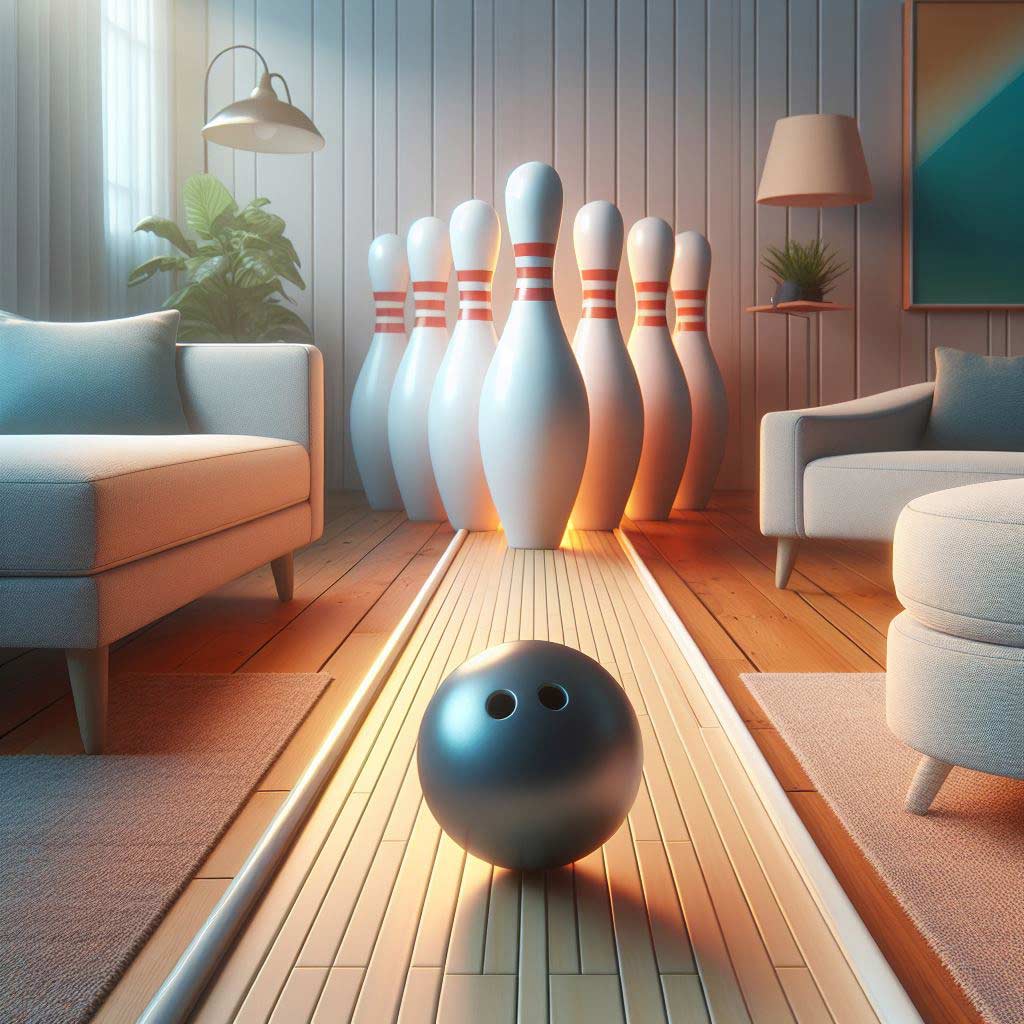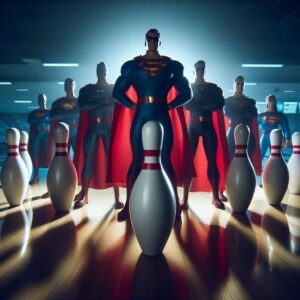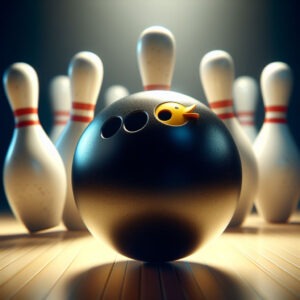If you love bowling but don’t have the space for a regulation lane, a mini bowling lane may be the perfect solution for your home or business. Mini lanes allow you to experience true bowling without taking up your entire basement or backyard.
In this comprehensive guide, we’ll explore what exactly mini bowling lanes are, their dimensions and equipment, benefits and usage scenarios, what to look for when buying one, installation considerations, maintenance best practices, and the top brands compared. Let’s start rolling!
What Exactly is a Mini Bowling Lane?
A mini bowling lane provides all the fun of bowling without requiring massive facility space. Mini lanes are downscaled versions made to fit areas as small as 225 square feet.
The smallest regulation bowling lane dimensions according to the United States Bowling Congress are 60 feet long by 41.5 inches wide. Mini bowling lanes can be as short as 12 feet long and 3 feet wide. The lowered ceilings of most home spaces make the average mini lane 15 to 25 feet in length.
Mini lanes allow for adjustable gutters, bumpers, ramp options, and ball and pin sizes to accommodate all ages and abilities, especially kids. Automated ball returns and scoring systems also accompany premium home mini lanes.
Typical dimensions for mini bowling lanes are:
- 15 to 25 feet long
- 3 to 5 feet wide
- A ceiling height of 8 feet or higher recommended
- Weights between 300 to 1,200 pounds
Having a shorter lane makes it easier for small children to roll balls hard enough to hit pins at the end. Lower operational heights also reduce weight and spatial requirements for mini bowling equipment and components.
Now that you understand exactly what a mini bowling lane entails dimension and equipment-wise, what scenarios warrant adding one and what benefits do they provide?
Benefits and Usage Scenarios for Mini Bowling Lanes
From game rooms to bars to event spaces, mini bowling lanes bring entertainment options to venues lacking room for large bowling facilities.
Residential Mini Lanes
Homes represent the most popular mini bowling lane installation locations. Families appreciate having endless recreation right inside without needing to constantly visit a bowling alley or arcade. Compact lanes fit well in spaces like basements, garages, spare bedrooms, or even the backyard.
Apart from casual family fun, mini lanes inject activity into children’s birthday parties, sleepovers with friends or visiting relatives. Adults also enjoy personal lanes for hosting Super Bowl parties, playing evening leagues with neighbors, or settling sibling rivalries.
Commercial Mini Lanes
Retail mini bowling lanes attract customers to businesses like restaurants, bars, breweries, clubs, and more. Having small lanes encourages patrons to stay longer while providing memory-making entertainment.
Companies also install mini bowling lanes to offer alternative activity for team building events, corporate parties, employee luncheons, trade shows, and conventions. Focus group facilities and market research companies now incorporate mini lanes to evaluate consumer response to brands and products in an engaging environment.
Cruise ship operators equip the latest luxury liners with compact lanes to entertain passengers of all ages and satisfaction levels. Given the confinement of onboard space, mini bowling components suit maritime recreation perfectly.
Some benefits of mini bowling lanes include:
- Provide bowling fun without massive space requirements
- Adjustable configurations to suit all ages and skill levels
- Bring entertainment options to small businesses like bars, retail stores, etc.
- Inject activity into homes, parties, and corporate events
- Work great in non-traditional bowling spaces like ships and backyard patios
- Components are smaller and weigh less than regulation equipment
Now that you see the flexible range of mini bowling lane benefits across residential, commercial, and specialty spaces like event venues and cruise ships, what should smart buyers evaluate when researching the purchase of compact lane equipment?
What To Look For When Buying a Mini Bowling Lane
Several considerations go into choosing quality mini bowling gear that suits your setting and needs:
Lane Construction
The lane itself comes in materials like wood laminates or synthetic composites. Natural maple offers an authentic traditional feel, but synthetic stands up better to liquid spills at bars or outdoor installations in humidity. Enclosed ball returns and gutters also improve longevity.
Dimensions
Consider the overall length based on room size constraints. Short 12 to 15-foot lengths severely limit pin configurations and scoring complexity compared to 20 to 25-foot lanes. Width affects the number of players. Have an odd number between 3 to 5 feet to allow 2 to 4 bowlers.
Balls and Pins
Look for regulation size and weight balls and pins. Some manufacturers use lighter equipment more like toys than real bowling components. Mini balls should be between 6 to 10 pounds for adults or lighter for children.
Scoring System
Manual scoring sheets work but get an electronic scorer and display for automated counts with advanced metrics and machine interfacing. Consider score posting to social media or networked competition between multiple lanes.
Brand Comparisons
Market leaders include Atomic Bowling, QubicaAMF, Brunswick, and US Bowling. Look for reputable manufacturers that use quality materials for durability, provide detailed warranty protection, and include professional installation services. DIY construction is possible but complex.
Installation and Maintenance
What electrical, lighting, ventilation, and construction costs come with installing a mini bowling lane? We’ll cover that next.
Installation & Maintenance Considerations for Mini Lanes
While mini bowling lanes occupy much less real estate than traditional lanes, some preparation goes into proper installation and keeping them functioning smoothly long-term. Here are top considerations:
Electrical
Have an electrician run a 120-volt, 15 to 20-amp grounded circuit to safely operate the automated pinsetter machine. Look for UL-listed products. Proper lane lighting typically requires 500 watts.
Ventilation
Humidity damages wood lanes and steel components. Install an HVAC system or dedicated exhaust fan and intake venting to regulate any dampness during off hours. Dehumidifiers also help maintain 40 to 50 percent relative humidity.
Underlayment
The subsurface beneath a mini lane seriously impacts stability and bowling accuracy. Pour a level subsurface like concrete or hardwood to prevent swaying and buckling issues over time. An uneven floor telegraphs imperfections through the lane surface.
Assembly
Expect a professional mini bowling lane installation crew to take 8 to 16 hours across 1to 2 days depending on lane size and accessory count. DIY builders require weeks working solo. Most manufacturers ship disassembled units given weight limits and include professional installation services.
Maintenance
Basic upkeep involves quick touch-ups with an appropriate lane oil solution to maintain slide ability without buildup between more thorough cleanings when pins get reset. Maintenance frequency depends on usage volume. Synthetic lanes have lower care requirements than natural wood.
Look for reasonable parts, service and labor warranty coverage between 1 to 7 years for electronics, gutters, pins, ball lifts and other core mini lane components. Quality gear shouldn’t unexpectedly break with normal private use cases.
Conclusion
Adding a mini bowling lane gives homes, businesses, events, and even cruise ships endless entertainment options without consuming acres of real estate required for regulation 10-pin facilities.
Just 15 to 25-feet lengths make bowling possible almost anywhere to inject activity into game rooms, corporate team building sessions, bars looking to attract patrons, or even small backyard patios.
With choices spanning construction materials like wood vs synthetic lanes to scoring system automation levels, focus on reputable brands that back quality mini lane components with decent warranty protection. Consider dimensions that balance playability with installation footprint limits in the target location.
Research dimensions, warranty coverage, and brands carefully upfront to ensure picking compact equipment made to last for years of strikes, spares, and smiles. Professional installation also never hurts given electrical, construction, and finishing needs.
Now get ready to have some fun without needing tons of space! Add a mini bowling lane for entertainment possibilities almost anywhere.
Frequently Asked Questions
What is mini bowling called?
Mini bowling is also referred to as short-lane bowling or compact bowling. It provides a scaled-down bowling experience to fit smaller residential and commercial spaces.
What is a mini-bowling game?
A mini-bowling game uses downsized lanes, balls, and pins that allow people to play authentic bowling without needing massive facilities. Typical mini bowling games take place on lanes 12 to 25 feet long and games follow standard 10-pin bowling rules and scoring.
How much space do you need for a mini-bowling alley?
A mini bowling alley can fit into spaces as small as 225 square feet. Recommended ceilings are 8 feet high with room dimensions allowing 15 – 25 feet in length and 3 – 5 feet in width to accommodate 1-4 players.
How many pins are in a mini bowling?
Mini bowling uses standard 10 pins just like regulation bowling. Some small-scale home versions made more like toys may use fewer pins, but authentic mini lanes equipment follows the official 10-pin bowling format.
Is duckpin bowling still around?
Yes, duckpin bowling remains popular in select areas like New England and parts of the Mid-Atlantic states. It uses shorter and squatter pins along with smaller balls without finger holes. Games tend to score higher than traditional 10-pin bowling.
What is the difference between bowling and mini bowling?
The main difference is scale. Mini bowling uses smaller lanes around 12 – 25 feet long compared to regulation 60-foot lanes. Balls, pins and other equipment are smaller. Mini bowling allows play in much less space at the cost of limited lane length affecting complexity.
How do you strike in mini bowling?
Scoring strikes in mini bowling follows the same concept as regulation 10-pin bowling – knocking down all 10 pins in one roll. The shorter lane length can make strikes more challenging on compact mini lanes. Utilizing adjustable bumpers can help increase strike percentage.
What is mini feather bowling?
Mini feather bowling is inspired by the Italian game of bocce and is played outdoors using small balls and portable target pins. It has very little relation to mini versions of 10-pin bowling played on compact lanes.
What is Duckpin bowling game?
Duckpin bowling is a variation popular on the East Coast U.S. played with squat, flat-bottomed pins and balls without finger holes that give games a fast pace with higher scoring potential. Five people typically play each frame rather than individuals taking turns.





